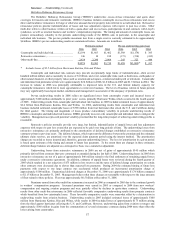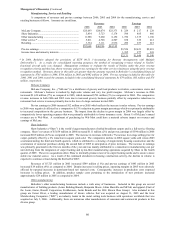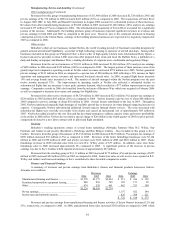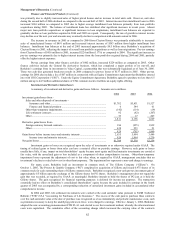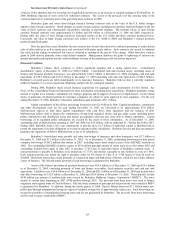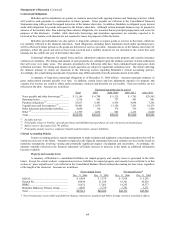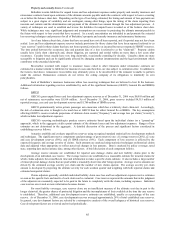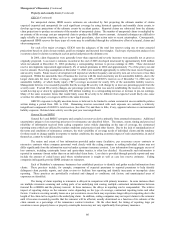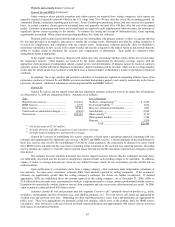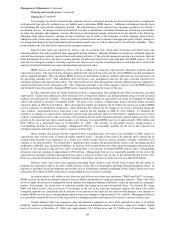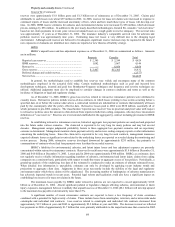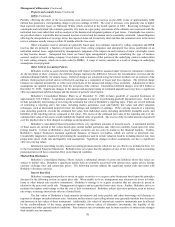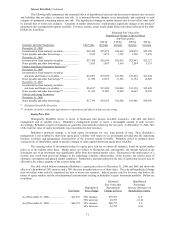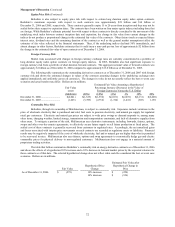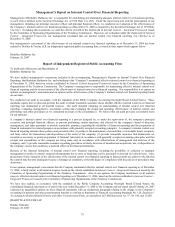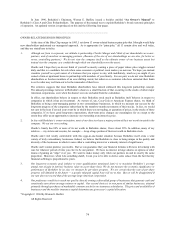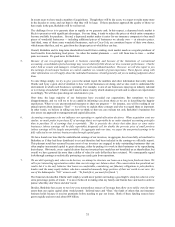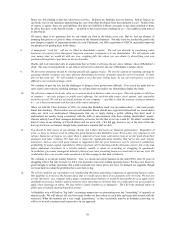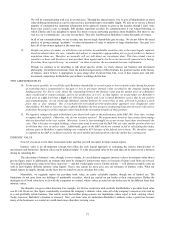Berkshire Hathaway 2006 Annual Report Download - page 68
Download and view the complete annual report
Please find page 68 of the 2006 Berkshire Hathaway annual report below. You can navigate through the pages in the report by either clicking on the pages listed below, or by using the keyword search tool below to find specific information within the annual report.
67
Property and casualty losses (Continued)
General Re and BHRG (Continued)
Under contracts where periodic premium and claims reports are required from ceding companies, such reports are
generally required at quarterly intervals which in the U.S. range from 30 to 90 days after the end of the accounting period. In
continental Europe, reinsurance reporting practices vary. Fewer clients report premiums, losses, and case reserves on a quarterly
basis. In certain countries, clients report on an annual basis and generally not until 90 to 180 days after the end of the annual
period. Estimates of premiums and losses are accrued based on expected results supplemented when necessary for estimates of
significant known events occurring in the interim. To monitor the timing and receipt of information due, client reporting
requirements are tracked. When clients miss reporting deadlines, the clients are contacted.
Premium and loss data is provided through at least one intermediary (the primary insurer), so there is a greater risk that
the loss data provided is incomplete, inaccurate or outside the coverage terms. Information provided by ceding companies is
reviewed for completeness and compliance with the contract terms. Reinsurance contracts generally allow for Berkshire’s
reinsurance subsidiaries to have access to the cedant’s books and records as regards to the subject business and provide them the
ability to conduct audits to determine the accuracy and completeness of information. Such audits are conducted when
management deems it appropriate.
In the regular course of business, disputes with clients may arise concerning whether certain claims are covered under
the reinsurance policies. Most disputes are resolved by the claims departments by discussing coverage aspects with the
appropriate client personnel or independent outside counsel review and determination. If disputes cannot be resolved, contracts
generally specify whether arbitration, litigation, or alternative dispute resolution will be invoked. There are no coverage disputes
at this time for which an adverse resolution would likely have a material impact on Berkshire’s results of operations or financial
condition.
In summary, the scope, number and potential variability of assumptions required in estimating ultimate losses from
reinsurance contracts of General Re and BHRG are more uncertain than primary property and casualty insurers due to the factors
previously discussed. Additional information concerning General Re and BHRG follows.
General Re
General Re’s gross and net unpaid losses and loss adjustment expenses and gross reserves by major line of businesses
as of December 31, 2006 are summarized below. Amounts are in millions.
Type Line of business
Reported case reserves ............................... $11,074 Workers’ compensation (1) ......................... $ 3,206
IBNR reserves ............................................ 9,370 Professional liability (2) .............................. 1,832
Gross reserves ............................................ 20,444 Mass tort–asbestos/environmental ............. 1,853
Ceded reserves and deferred charges.......... (2,083) Auto liability.............................................. 2,902
Net reserves................................................ $18,361 Other casualty
(3) ........................................ 4,129
Other general liability................................ 3,588
Property ..................................................... 2,934
Total ............................................. $20,444
(1) Net of discounts of $2,761 million.
(2) Includes directors and officers and errors and omissions coverage.
(3) Includes medical malpractice and umbrella coverage.
General Re’s process of establishing loss reserve estimates is based upon a ground-up approach, beginning with case
estimates and supplemented by additional case reserves (“ACRs”) and IBNR reserves. Critical judgments in the establishment of
these loss reserves may involve the establishment of ACRs by claim examiners, the expectation of ultimate loss ratios which
drive IBNR reserve amounts and the case reserve reporting trends compared to the expected loss reporting patterns. Recorded
reserve amounts are subject to “tail risk” where reported losses develop beyond the maximum expected loss emergence pattern
time period.
The company does not routinely determine loss reserve ranges because it believes that the techniques necessary have
not sufficiently developed and the myriad of assumptions required render such resulting ranges to be unreliable. In addition,
counts of claims or average amounts per claim are not utilized because clients do not consistently provide reliable data in
sufficient detail.
Upon notification of a reinsurance claim from a ceding company, claim examiners make independent evaluations of
loss amounts. In some cases, examiners’ estimates differ from amounts reported by ceding companies. If the examiners’
estimates are significantly greater than the ceding company’s estimates, the claims are further investigated. If deemed
appropriate, ACRs are established above the amount reported by the ceding company. As of December 31, 2006, ACRs of
$3.4 billion before discounts were concentrated in workers’ compensation and to a lesser extent in professional liability reserves.
Examiners also periodically conduct claim reviews at client companies and case reserves are often increased as a result. In 2006,
claim examiners conducted about 450 claim reviews.
Actuaries classify all loss and premium data into segments (“reserve cells”) primarily based on product (e.g., treaty,
facultative, and program) and line of business (e.g., auto liability, property, etc.). For each reserve cell, losses are aggregated by
accident year and analyzed over time. Depending on client reporting practices, some losses and premiums are aggregated by
policy year. These loss aggregations are internally called loss triangles, which serve as the primary basis for IBNR reserve
calculations. Over 300 reserve cells are reviewed for North American business and approximately 900 reserve cells are reviewed
with respect to international business.


